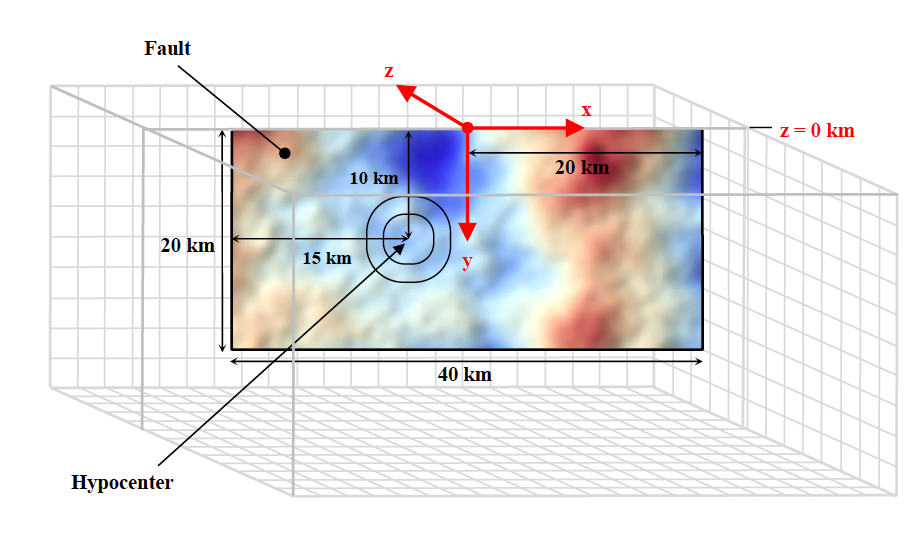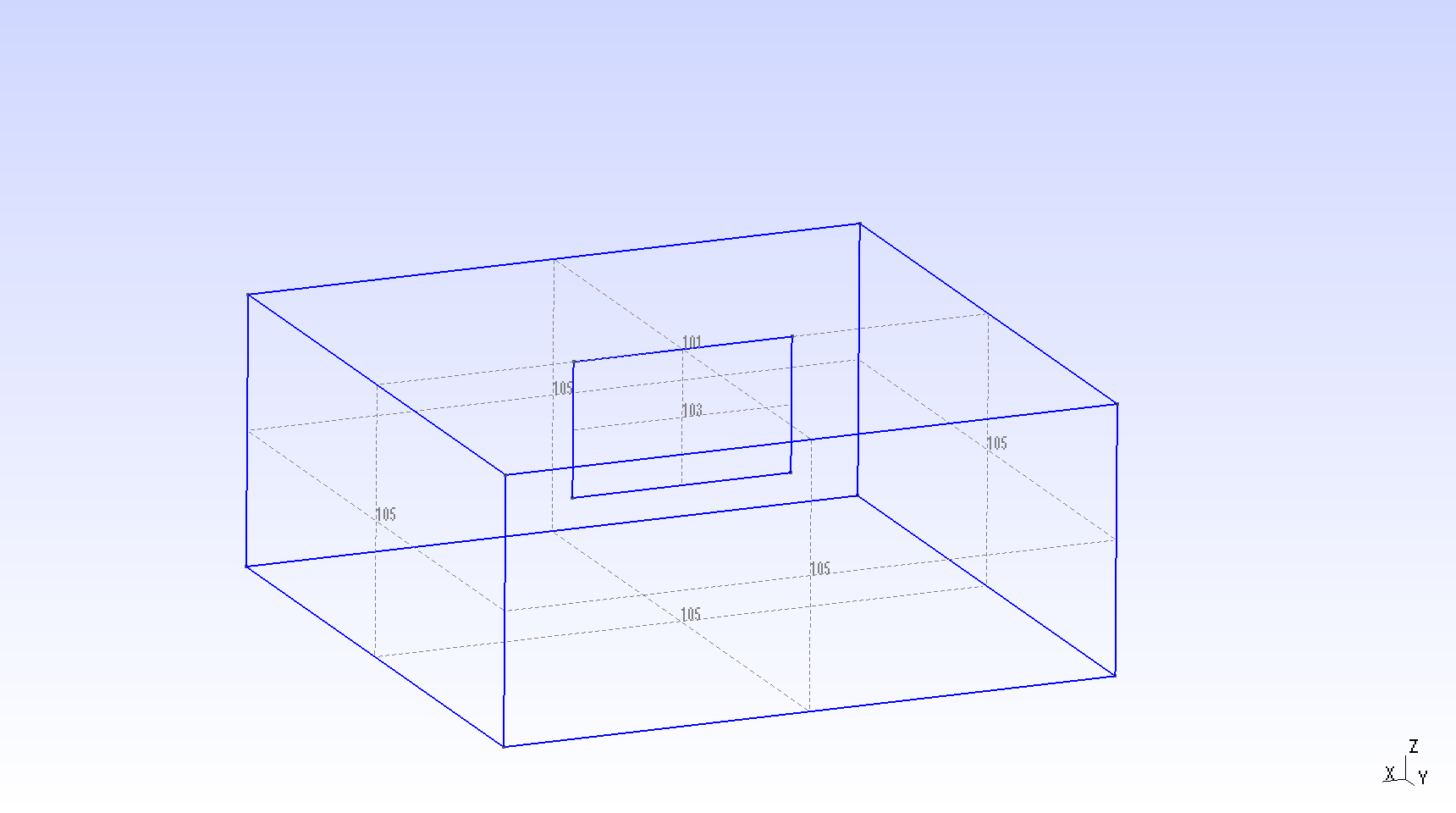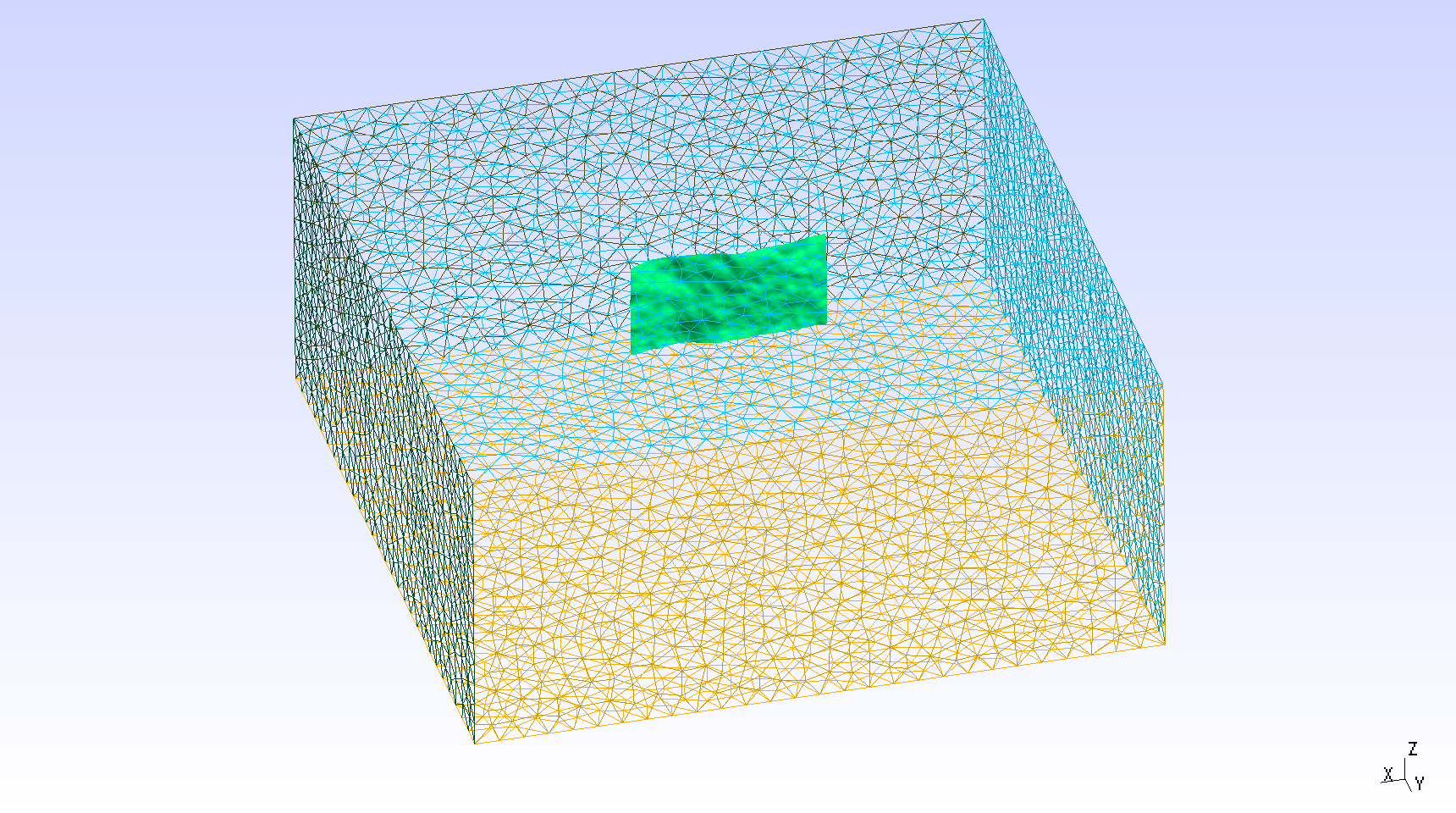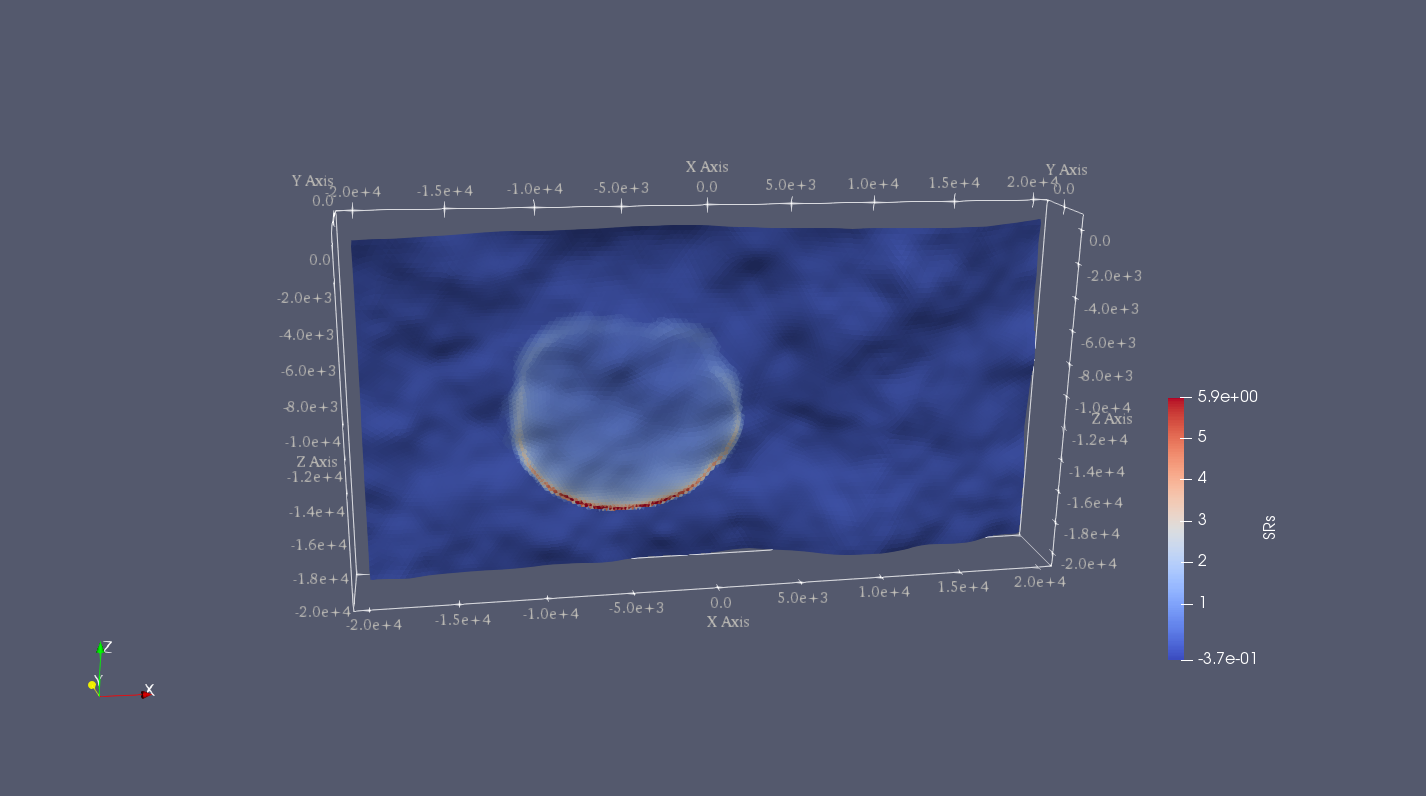SCEC TPV29
TPV 29 contains a vertical, right-lateral fault with rough fault interface (Figure [fig:tpv29]). The fault surface has 3D stochastic geometrical roughness (blue and red colors). In TPV 29, the surrounding rocks respond elastically.

Diagram of TPV 29. The fault is 40 km long along the strike. There is a circular nucleation zone on the right-lateral fault surface. The fault surface has 3D stochastic geometrical roughness (blue and red colors). The hypocenter is located 15 km from the left edge of the fault, at a depth of 10 km.
Geometry
The roughed fault interface model is generated with Gmsh is complicated than planar faults in previous sections. There are 5 steps to generate the model.
- 1.Download fault topography data from SCEC. There are 2001 nodes
along the strike and 1201 nodes along the downdip. The node files should contain:
Line 1: nx, ny
Line 2 to nx: positions of nodes along the strike (in meters)
Line nx+3 to ny+nx+3: positions of nodes along the downdip (in meters)
Line to the end: fault topography of each nodes (nx\*ny, in meters)
Using generate_mytopo_tpv29.py to create the topography data.
2.Make a model with plane fault as Figure [fig:tpv29geo]. The Gmsh tpv29.geo file can be found at https://github.com/SeisSol/Examples/blob/master/tpv29/tpv29.geo.

Diagram showing the geometry of TPV 29. The center of nucleation is at (-8, 0, -10) km on the main fault.
3.Use gmsh_plane2topo.f90 and interpol_topo.in* to shift the planar fault according to positions given in mytopo_tpv29.
$ ./gmsh_plane2topo interpol_topo.in
This will generate a step1_modified.msh file which containing rough fault surface.
4.Make a new step2.geo file that contains the new rough fault and mesh following general Gmsh process.

Diagram showing the geometry of TPV 29. The center of nucleation is at (-8, 0, -10) km on the main fault.
Generate MSH mesh with the command line:
& gmsh tpv29_step2.geo -3 -optimize_netgen -o tpv29_step2.msh
option optimize_netgen is necessary for optimizing meshing with good quality.
6.Then convert the .msh file to 3D Gambit neutral file and PUML format as same as shown in TPV5
- ::
$ gmsh2gambit -i tpv29_step2.msh -o tpv29.neu $ pumgen tpv29.neu tpv29
The mesh can be created by using the bash script https://github.com/SeisSol/Examples/blob/master/tpv29/generating_the_mesh.sh.
Here we show a fully opensource workflow which allows generating a mesh accounting for tpv29 rough fault geometry. This yields a mesh that does not properly account for the intersection between fault and the free-surface. We note that it is here not an important issue, as the tpv29 benchmark does not feature surface rupturing. Another drawback of this workflow is that the rate of mesh size coarsening is not easy parametrizable. A more straightforward and accurate way to generate a mesh would be to use simModeler.
Material parameters
In TPV29, the entire model volume is a linear elastic material, with the following parameters listed in Table [table:tpv29material].
Parameter |
Description |
Value |
Unit |
|---|---|---|---|
\(\rho\) |
density |
2670 |
\(kg/m^{3}\) |
\(\lambda\) |
Lame’s first parameter |
3.2044e10 |
Pa |
\(\mu\) |
shear module |
3.2038e10 |
Pa |
\(h_{edge}\) |
element edge length |
200 |
m |
\(V_p\) |
P wave velocity |
6000 |
m/s |
\(V_s\) |
S wave velocity |
3464 |
m/s |
[table:tpv29material]
Initial stress
The initial stress are listed in Table [table:tpv29fault].
Parameter |
Description |
Value |
Unit |
|---|---|---|---|
mu_s |
static friction coefficient |
0.12 |
|
mu_d |
dynamic friction coefficient |
0.18 |
|
d_c |
critical distance |
0.30 |
m |
s_zz |
\(\sigma_{zz}\) |
-2670*9.8*depth |
Pa |
Pf |
fluid pressure |
1000*9.8*depth |
Pa |
s_xz,s_yz |
\(\sigma_{xz}, \sigma_{yz}\) |
0 |
Pa |
s_yy |
\(\Omega * b33*(\sigma_{zz} + P_f) - P_f\) |
Pa |
|
s_xx |
\(\Omega * b11*(\sigma_{zz} + P_f) - P_f\) |
Pa |
|
s_xy |
\(\Omega * b13*(\sigma_{zz} + P_f)\) |
Pa |
Table: Table of initial stress in TPV 29. \(b11, b33,b13\) are 1.025837, 0.974162, −0.158649, respectively.
\[\begin{split}\bar{\sigma}_{effective}= \begin{bmatrix} &\sigma_{xx} + P_f , & \sigma_{xy} ,& \sigma_{xz} \\ &\sigma_{xy}, &\sigma_{yy} +P_f , &\sigma_{yz} \\ &\sigma_{xz} ,&\sigma_{yz} , &\sigma_{zz} +P_f \end{bmatrix}\end{split}\]
where \(\Omega\) is defined as:
Nucleation parameters
TPV29 uses a similar strategy for dynamic rupture nucleation.
The cohesion zone is defined as :
The friction parameters on the fault are listed in Table [table:tpv29fric].
Parameter |
Description |
Value |
Unit |
|---|---|---|---|
mu_s |
static friction coefficient |
0.12 |
|
mu_d |
dynamic friction coefficient |
0.18 |
|
d_c |
critical distance |
0.30 |
m |
t_0 |
forced rupture delay time |
0.5 |
s |
Table: Table of friction parameters in TPV 29.
Results
The earthquake rupture is artificially nucleated in a circular zone on the fault surface.

Snapshot of slip rate along the strike at T=3 s in TPV 29. The fault has a rough surface.